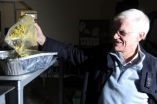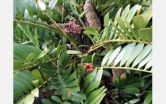(Press-News.org) Scientists investigating the allergic reactions that asthmatics suffer towards a common mould have discovered that many people with asthma actually had the mould growing in their own lungs.
The research led by University of Leicester scientists at Glenfield Hospital has been published in the December 2010 issue of the American Journal of Respiratory and Critical Care Medicine.
The team based in the Institute for Lung Health at the University of Leicester and Glenfield Hospital examined the impact on asthmatics of a common environmental mould, Aspergillus fumigates, usually found in soil and compost heaps.
Professor Andy Wardlaw from the University of Leicester said: "Asthma is a very common condition where the breathing tubes (bronchi) can go into spasm making it difficult to breathe. Around a fifth of adults with severe asthma, which they have had for a long time, get permanent (fixed) narrowing of their bronchi. It is known that A. fumigatus can grow in the lungs of some people with asthma and mould allergy, which can cause severe lung damage.
"This problem is thought to only affect a very small number of people with asthma; however, about half of people with severe asthma have evidence of allergy to moulds like A. fumigatus."
Researchers in the Institute for Lung Health at the University of Leicester and Glenfield Hospital, Leicester, carried out a study funded by the Midlands Asthma and Allergy Research Association (MAARA, a Midlands based charity funding research into asthma and allergy research. www.maara.org) and the European Regional Development Fund (ERDF), to determine whether the problem of A. fumigatus growing in the lungs is more common than previously thought, and whether this could explain the fixed narrowing of the airways that occurs in some people with asthma.
Professor Wardlaw added: "Our study showed that 6 out of 10 people with asthma who were allergic to A. fumigatus grew the mould from their sputum. We also found that if you were allergic to A. fumigatus you had more narrowing of the airways than if you were not allergic, and this was worse in patients from whom A. fumigatus was grown.
"Our research concluded that it is possible that fixed narrowing of breathing tubes in many people with asthma could be caused by A. fumigatus growing in their lungs.
"Treating individuals from whom A. fumigatus is detected with antibiotics against the mould may prevent fixed narrowing of the airways. "
###
NOTE TO NEWSDESK: For more information, please contact: Professor Andy Wardlaw, Tel: 0116 256 3841 (Secretary, Gail Fretter)
New asthma research breaks the mold
Study finds cause of allergic reaction could be growing in your lungs
2010-12-15
ELSE PRESS RELEASES FROM THIS DATE:
Scientists identify how virus triggers cervical and mouth cancer
2010-12-15
University of Manchester scientists have discovered for the first time an important new way in which the human papilloma virus (HPV) triggers cancer in what could lead to new treatments for cervical and mouth cancer.
HPV infection is known to increase the risk of developing cancers of the cervix and mouth with the two high-risk forms of the virus accounting for approximately 70% of all cervical cancer cases.
Vaccinations against these high-risk forms of HPV should reduce the incidence of cervical cancer but the frequency of mouth cancer actually increased in the UK ...
More than 25 percent of teenagers have suffered cyber bullying in the past year
2010-12-15
Cyber bullying is an emerging phenomenon that is becoming increasingly common among teenagers. Research by the University of Valencia (UV), based on a study carried out in the region, shows that between 25% and 29% of all teenagers have been bullied via their mobile phone or the internet over the past year.
"The data from our study shows that technological bullying affects 24.6% of teenagers in the case of mobile telephony, and 29% with regard to the internet. In the large majority of cases, this abuse lasts for a month or less", Sofía Buelga, co-author of the study and ...
100 percent of most challenging Christmas plastic wrapping could be recycled by new tech
2010-12-15
On average we each consume 120 grammes of plastic wrapping on Christmas gifts most of which is of a type which is almost impossible to recycle. Now researchers at the University of Warwick have devised a new technique which could process 100% of Christmas and other household plastic instead of the tiny fraction that currently actually gets processed - typically only 12% of such waste is truly recycled often the rest is often put into land fill or simply burnt as fuel.
Some plastic still goes straight to land fill but householders currently spend a great deal of effort ...
The sweetness of biodegradable plastics
2010-12-15
Tel Aviv ― Environmentalists around the world agree ― plastic bags are choking our landfills and polluting our seas. Now a Tel Aviv University researcher is developing new laboratory methods using corn starch and sugar to help sustainable plastics –– those that biodegrade and are even tougher than those made from petrochemicals –– compete in the industry.
The answer to the problem, Prof. Moshe Kol of Tel Aviv University's School of Chemistry says, is a new variety of catalysts ― substances that initiate or sustain chemical reactions in other substances. ...
Fighter pilots' brains are 'more sensitive'
2010-12-15
Cognitive tests and MRI scans have shown significant differences in the brains of fighter pilots when compared to a control group, according to a new study led by scientists from UCL.
The study, published today in the Journal of Neuroscience, compares the cognitive performance of 11 front-line RAF (Royal Air Force) Tornado fighter pilots to a control group of a similar IQ with no previous experience of piloting aircraft. All the participants completed two 'cognitive control' tasks which were used to investigate rapid decision making. Diffusion tensor imaging (DTI), a ...
Environmental pharmaceutical contamination removed by Octolig
2010-12-15
An article in the current issue of TECHNOLOGY & INNOVATION, Proceedings of the National Academy of Inventors ™ http://www.cognizantcommunication.com/filecabinet/Technology/techinnovation.html reports on the removal of certain dyes and the antibiotic amoxicillin from water samples using Octolig ®, a commercially available material.
"Because of their properties and the magnitude of their production and use, pharmaceuticals can represent a serious disposal problem," said corresponding author* Dean F. Martin, PhD, of the University of South Florida's Institute for Environmental ...
2 people receive kidney transplants in pilot program using CMU software
2010-12-15
PITTSBURGH—A man in St. Louis and a woman in New Hampshire have received the first kidney transplants made possible through a new national program of the Organ Procurement and Transplantation Network (OPTN) that uses a Carnegie Mellon University computer algorithm to match transplant candidates with living donors.
Both recipients — Ken Crowder of St. Louis and Kathy Niedzwiecki of Pelham, N.H. — had loved ones who were willing to donate a kidney but who were medically incompatible with them. So, through a paired donation, Mr. Crowder's fiancée, Rebecca Burkes, donated ...
A protein called cFLIP makes tumor cells in breast cancer resistant to treatments
2010-12-15
Researchers at the Andalusian Institute for Molecular Biology and Regenerative Medicine (CABIMER) and the University of Granada found that cFLIP –an inhibitor of death ligand-induced apoptosis– is not only essential in breast tumor cells resistance to TRAIL treatments (a death ligand with a potent therapeutic potential against cancer), but this protein is also key to the survival of such cancer cells.
Researchers proved that a variation in the expression of this protein may lead to the normal development of breast epithelium. This is an important finding to be considered ...
Hubble spots a celestial bauble
2010-12-15
The delicate shell, photographed by the NASA/ESA Hubble Space Telescope, appears to float serenely in the depths of space, but this apparent calm hides an inner turmoil. The gaseous envelope formed as the expanding blast wave and ejected material from a supernova tore through the nearby interstellar medium. Called SNR B0509-67.5 (or SNR 0509 for short), the bubble is the visible remnant of a powerful stellar explosion in the Large Magellanic Cloud (LMC), a small galaxy about 160 000 light-years from Earth.
Ripples seen in the shell's surface may be caused either by subtle ...
What 'pine' cones reveal about the evolution of flowers
2010-12-15
From southern Africa's pineapple lily to Western Australia's swamp bottlebrush, flowering plants are everywhere. Also called angiosperms, they make up 90 percent of all land-based, plant life.
New research published this week in the Proceedings of the National Academy of Sciences provides new insights into their genetic origin, an evolutionary innovation that quickly gave rise to many diverse flowering plants more than 130 million years ago. Moreover, a flower with genetic programming similar to a water lily may have started it all.
"Water lilies and avocado flowers ...
LAST 30 PRESS RELEASES:
Injectable breast ‘implant’ offers alternative to traditional surgeries
Neuroscientists devise formulas to measure multilingualism
New prostate cancer trial seeks to reduce toxicity without sacrificing efficacy
Geometry shapes life
A CRISPR screen reveals many previously unrecognized genes required for brain development and a new neurodevelopmental disorder
Hot flush treatment has anti-breast cancer activity, study finds
Securing AI systems against growing cybersecurity threats
Longest observation of an active solar region
Why nail-biting, procrastination and other self-sabotaging behaviors are rooted in survival instincts
Regional variations in mechanical properties of porcine leptomeninges
Artificial empathy in therapy and healthcare: advancements in interpersonal interaction technologies
Why some brains switch gears more efficiently than others
UVA’s Jundong Li wins ICDM’S 2025 Tao Li Award for data mining, machine learning
UVA’s low-power, high-performance computer power player Mircea Stan earns National Academy of Inventors fellowship
Not playing by the rules: USU researcher explores filamentous algae dynamics in rivers
Do our body clocks influence our risk of dementia?
Anthropologists offer new evidence of bipedalism in long-debated fossil discovery
Safer receipt paper from wood
Dosage-sensitive genes suggest no whole-genome duplications in ancestral angiosperm
First ancient human herpesvirus genomes document their deep history with humans
Why Some Bacteria Survive Antibiotics and How to Stop Them - New study reveals that bacteria can survive antibiotic treatment through two fundamentally different “shutdown modes”
UCLA study links scar healing to dangerous placenta condition
CHANGE-seq-BE finds off-target changes in the genome from base editors
The Journal of Nuclear Medicine Ahead-of-Print Tip Sheet: January 2, 2026
Delayed or absent first dose of measles, mumps, and rubella vaccination
Trends in US preterm birth rates by household income and race and ethnicity
Study identifies potential biomarker linked to progression and brain inflammation in multiple sclerosis
Many mothers in Norway do not show up for postnatal check-ups
Researchers want to find out why quick clay is so unstable
Superradiant spins show teamwork at the quantum scale
[Press-News.org] New asthma research breaks the moldStudy finds cause of allergic reaction could be growing in your lungs




